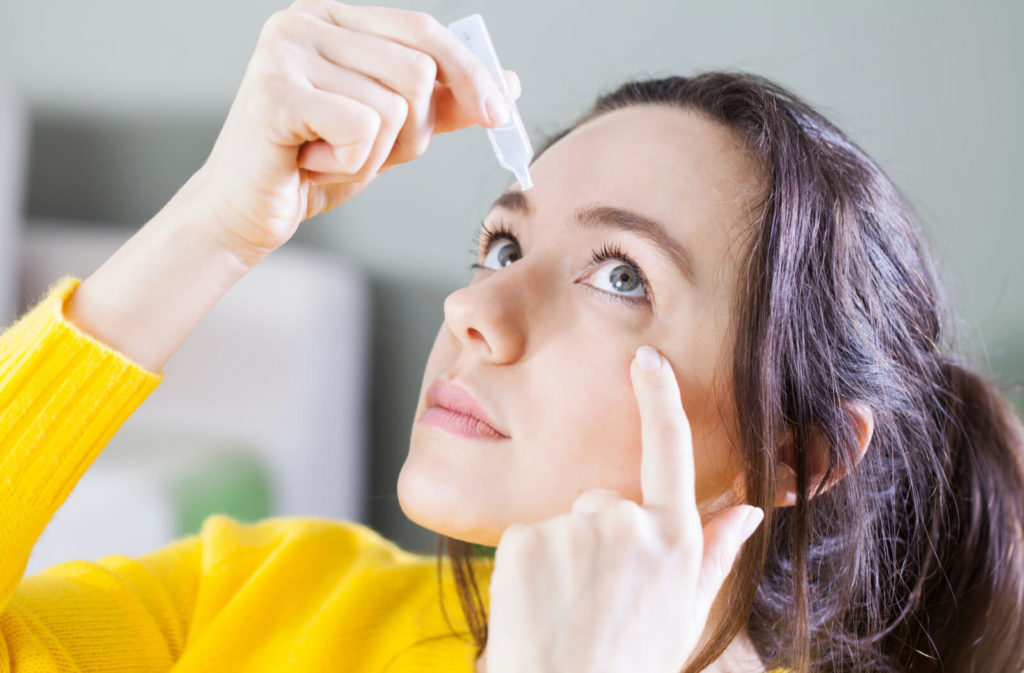We know that with an increase in the usage of digital devices, a common complaint is dry eyes related to digital eye strain. But you can also experience dry eyes and irritation from wearing contact lenses.
Dry eyes can be detected and diagnosed during a routine eye exam. An early diagnosis is crucial to protecting your vision and eye health. Read on to learn more about dry eyes, contact lens-related dry eyes, treatment options, and what contact lenses to wear for dry eyes.
All About Dry Eyes
Dry eyes, also known as dry eye disease (DED) or dry eye syndrome (DES), is a condition caused by the lack of lubrication in the eye. Either you produce poor quality tears or insufficient tears, affecting your eye comfort and ocular health.
The tear film should comprise water, mucous, and oil to keep the eyes moist and prevent your tears from evaporating. When there is an imbalance, you can experience dry eye symptoms.
Symptoms associated with dry eyes include:
- Burning
- Eye pain, strain, & irritation
- Redness
- Blurry vision
- Grittiness
- Watery eyes
- Light sensitivity
There are several causes of dry eyes:
- Age
- Certain medications
- Systemic Conditions
- Hormones
- Allergies
- Environmental factors
- Eye surgery
- Prolonged screen usage
- Long-term contact lens wear
Contact Lens-Related Dry Eyes
Contact lens discomfort (CLD) from dry eyes is the most common reason for contact lens wearer dropout. So what is contact lens-related dry eyes?
In eyes with healthy tear production, the contact lens sits over the tear film on the cornea (the clear dome on the front of the eye). Lack of tears or poor-quality tears affects this tear film and can lead to increased friction between the contact lens and the eye’s surface, causing discomfort.
Contact lenses need to absorb tears to remain soft and maintain their shape. When the eyes lack stable, high-quality tears, contacts become less flexible and can cause irritation. Tears keep your eyes healthy and comfortable, so dry eye symptoms often worsen throughout the day because of the eye’s inability to stay hydrated.
Contact lenses can also cause discomfort and dry eyes because of:
- Design
- Material
- Hygiene routine
- Length of time worn
Treatment for Dry Eyes
There’s no cure for dry eyes, but there are treatment options that can help you manage symptoms. Dry eye therapy can include the following:
- Artificial tears
- Medicated eye drops and ointments
- Warm compresses
- Eye masks
- Nutrition and diet adjustments
- Environmental changes
Contact Lenses for Dry Eyes
You may consider giving up your contact lenses because of dry eyes. But before you do that, here are some ways to achieve comfortable, clear vision with contact lenses:
Lens Material
Lens technology has come a long way, with a range of contact lenses available to suit almost everyone. Soft and hard contact lens materials can offer extreme breathability, allowing more oxygen to reach the cornea. Soft hydrogel contact lenses can keep your eyes comfortable longer.
Daily disposable contacts are also extremely comfortable. Along with convenience, daily contacts help prevent protein buildup, resulting in more comfort without irritation and dryness.
Water Content
High water content in contact lenses can actually dry out your eyes. While they provide adequate moisture at the onset, they absorb more of the tear film. Your eye doctor can determine what lenses can work best for you.
Lens Size
Most contact lenses sit on the cornea. Scleral contact lenses are specialty contacts that cover the sclera, the whites of the eye. These lenses can work well for people with dry eyes because they create a tear reservoir.
Lens Solution
If the problem is not with your contacts, it can be your lens solution. Using lens solution with preservatives can irritate or dry your eyes.
Always use the recommended solution for your contact lenses, or speak to your eye doctor about choosing a different type or brand.
Measures to Avoid Dry Eyes with Contact Lenses
Here are some steps you can take to help avoid dry eyes when you wear contact lenses:
- Have a contact lens exam and fitting with an optometrist to ensure you try the best lens style and fit for your unique eye needs.
- Only wear high-quality lenses prescribed by your eye doctor.
- Avoid wearing your contact lenses longer than the recommended time.
- Maintain a thorough contact lens hygiene routine based on your contact lens type.
Dry Eye Relief
If you experience dry eye symptoms, don’t be so quick to ditch your contact lenses. The River Heights Eye Care team is here to listen to your concerns and provide a treatment plan. Book an appointment today and get ready to say goodbye to dry eyes.


